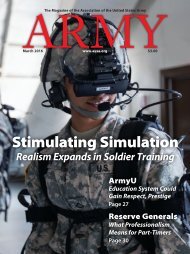Army - Kicking Tires On Jltv
You also want an ePaper? Increase the reach of your titles
YUMPU automatically turns print PDFs into web optimized ePapers that Google loves.
U.S. <strong>Army</strong>/John Hamilton<br />
During testing at White Sands Missile Range, N.M., clockwise from top inset: An M270A1 MLRS fires a training rocket; an improved armored cab affords<br />
more crew protection; the redesigned cab puts the commander in the center.<br />
exploded ordnance … and with the different ways a bomblet<br />
can hit, there’s almost no way you can guarantee a less than 1<br />
percent dud rate.”<br />
The solution came in the form of the alternative warhead program.<br />
Lockheed Martin worked with Orbital ATK to develop a<br />
new warhead for the guided multiple launch rocket system that<br />
features a high-explosive core surrounded by tungsten balls.<br />
“We’re talking about 186,000” medium- and small-caliber<br />
balls, Musculus said, so when the rocket detonates, the smallcaliber<br />
balls are “going everywhere. It’s used for imprecisely located<br />
targets and also for soft targets.”<br />
The engineering and manufacturing development program<br />
for the new warhead program began in March 2012, Musculus<br />
said. Testing at White Sands Missile Range, N.M., resulted<br />
in “100 percent mission success,” with detonations providing<br />
“good effects on targets.”<br />
Tactical Missile Modernization<br />
Other efforts are directed toward old <strong>Army</strong> tactical missiles<br />
containing anti-personnel and anti-materiel (APAM) submunitions.<br />
“The government has a lot” of the Block I tactical missions<br />
in inventory, he said. “These are the old ones with the APAM<br />
warhead,” which will not be usable starting in 2018 because of<br />
the cluster munition ban.<br />
“So what we are doing is taking those old Block Is, bringing<br />
them in, downloading and de-mating them from the pod,<br />
salvaging a lot of the metal parts including the solid rocket<br />
motor, which we’re washing out and refilling the propellant<br />
so it’s like a brand-new motor,” he said. “We’re also building<br />
new navigation electronics and upgrading the processors; replacing<br />
the obsolete parts; doing the same replacement of obsolete<br />
parts for the mission computer and putting a new<br />
processor in there.”<br />
Musculus said new builds of the inertial measurement unit<br />
and control actuation system are also being added. As a result,<br />
what had once been seen as a service life-extension program<br />
is now dubbed modernization for the <strong>Army</strong>’s tactical<br />
missile system.<br />
“The systems are not stagnating,” Musculus said. “We are<br />
continuing to upgrade the electronics in them. We are putting<br />
new processors in. We are replacing the obsolete parts. We are<br />
developing new warheads that are compliant with policies and<br />
accords. We’re also putting new electronics in the launchers<br />
and have developed a new armored cab to protect the soldiers<br />
better. These are evolving products that are going to go on for<br />
many more years.”<br />
Musculus also said the restarted tactical missile system and<br />
HIMARS lines are attracting foreign interest. “Countries are<br />
now coming and saying, ‘Hey, we want to get in on that now.’<br />
So that’s a good story,” he said. “And where it’s really a great<br />
story is, as the foreign governments come in and buy these<br />
munitions, it obviously helps out our U.S. customer with better<br />
pricing.”<br />
✭<br />
62 ARMY ■ February 2016

















